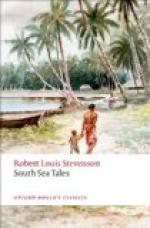In the afternoon the summer parlour was observed to be packed with people; others standing outside and stooping to peer under the eaves, like children at home about a circus. It was the Makin company, rehearsing for the day of competition. Karaiti sat in the front row close to the singers, where we were summoned (I suppose in honour of Queen Victoria) to join him. A strong breathless heat reigned under the iron roof, and the air was heavy with the scent of wreaths. The singers, with fine mats about their loins, cocoa-nut feathers set in rings upon their fingers, and their heads crowned with yellow leaves, sat on the floor by companies. A varying number of soloists stood up for different songs; and these bore the chief part in the music. But the full force of the companies, even when not singing, contributed continuously to the effect, and marked the ictus of the measure, mimicking, grimacing, casting up their heads and eyes, fluttering the feathers on their fingers, clapping hands, or beating (loud as a kettledrum) on the left breast; the time was exquisite, the music barbarous, but full of conscious art. I noted some devices constantly employed. A sudden change would be introduced (I think of key) with no break of the measure, but emphasised by a sudden dramatic heightening of the voice and a swinging, general gesticulation. The voices of the soloists would begin far apart in a rude discord, and gradually draw together to a unison; which, when, they had reached, they were joined and drowned by the full chorus. The ordinary, hurried, barking unmelodious movement of the voices would at times be broken and glorified by a psalm-like strain of melody, often well constructed, or seeming so by contrast. There was much variety of measure, and towards the end of each piece, when the fun became fast and furious, a recourse to this figure —
[Musical notation which cannot be produced. It means two/four time with quaver, quaver, crotchet repeated for three bars.]
It is difficult to conceive what fire and devilry they get into these hammering finales; all go together, voices, hands, eyes, leaves, and fluttering finger-rings; the chorus swings to the eye, the song throbs on the ear; the faces are convulsed with enthusiasm and effort.
Presently the troop stood up in a body, the drums forming a half-circle for the soloists, who were sometimes five or even more in number. The songs that followed were highly dramatic; though I had none to give me any explanation, I would at times make out some shadowy but decisive outline of a plot; and I was continually reminded of certain quarrelsome concerted scenes in grand operas at home; just so the single voices issue from and fall again into the general volume; just so do the performers separate and crowd together, brandish the raised hand, and roll the eye to heaven—or the gallery. Already this is beyond the Thespian model; the art of this people is already past the embryo: song, dance,




